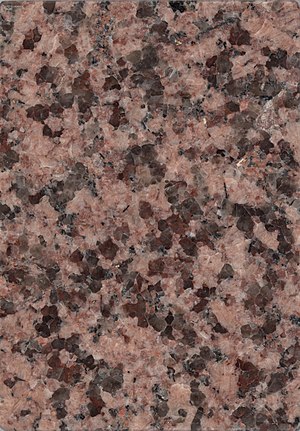Historical Geology/Minerals

In this article we shall introduce some useful basic definitions: in particular, we will look at the definition of a mineral and see how it is different from the definition of a rock.
Minerals
[edit | edit source]A crystal is defined as a solid in which the constituent atoms are arranged in an orderly repeating pattern. The diagram to the right, for example, is a ball-and-stick model of the molecular structure of halite. The large red balls represent atoms of chlorine; the small green balls represent atoms of sodium; the sticks represent the bonds between atoms.
A mineral is a naturally occurring inorganic solid which is defined by a chemical formula and a particular crystal structure. For example ice is a mineral since it meets all the requirements of being a mineral, and coal is not a mineral since it is organic.
Take for example the mineral halite (more familiar to you as table salt). It has the formula NaCl, because it is formed from units consisting of one atom of sodium (Na) and one atom of chlorine (Cl), and it has a cubic structure as shown in the diagram above. The formula and structure define the mineral.
It is perfectly possible to have two different minerals with exactly the same formula but different crystal structures. One commonly used example of this are the minerals diamond and graphite. Both consist entirely of atoms of carbon, and so have exactly the same chemical formula, but graphite has a hexagonal crystal system and diamond has a tetrahedral crystal system; as a result their physical properties are very different. Two minerals having the same formula but different molecular structures are known as polymorphs.
Some minerals are what is known as solid solutions. Take for example the mineral olivine. This has the formula (Mg,Fe)2SiO4. The part of the formula which says (Mg,Fe) indicates that there are positions in the crystal structure each of which can be filled by an atom of either magnesium (Mg) or iron (Fe). What proportion of these positions is filled by iron and what proportion is magnesium will vary from sample to sample of olivine. It is convenient to treat these as varieties of the same mineral.
There are thousands of known minerals, most of which are of interest chiefly to collectors, and which we can largely ignore in an introductory text such as this. Of those that we shall mention, far and away the most important class are the silicate minerals, and the next article will be devoted to their physical and chemical properties.
Mineraloids
[edit | edit source]
A mineraloid is a substance which is similar to a mineral in some respects but does not fulfill all the criteria necessary to be a mineral. There does not appear to be a complete consensus on what is a mineraloid and what is just a plain non-mineral, and the term is little-used.
One important sort of mineraloid is naturally occurring glass, such as obsidian or pumice. Glass by definition does not have a crystal structure, but is a confused mess at the molecular level. Such a structure, or rather lack of structure, is described as being amorphous.
Rocks
[edit | edit source]A rock is an aggregate of one or more minerals or mineraloids. For example granite consists mainly of the minerals quartz, mica and feldspar. In granite the crystals of the different minerals are actually visible to the naked eye, giving it its characteristic speckled appearance, as in the picture to the right.
A rock can consist of a single mineral: for example the semi-precious stone known to dealers in gemstones as "rock crystal" consists entirely of quartz.